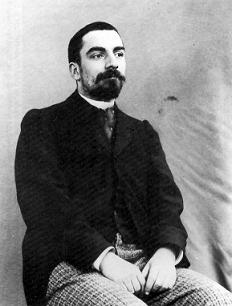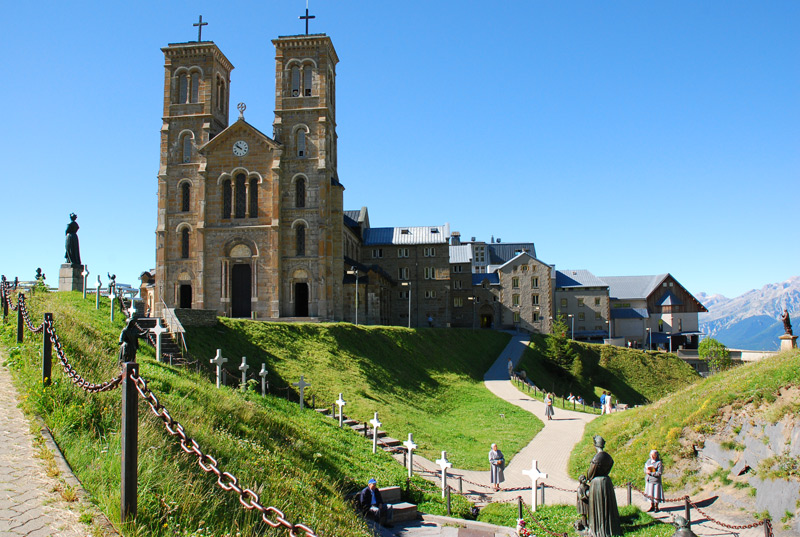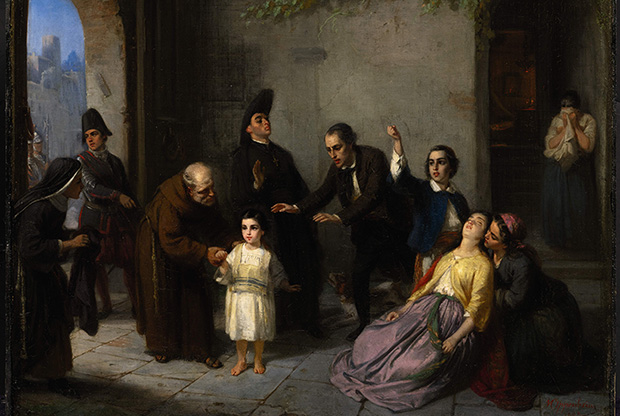|
Louis Veuillot
Louis Veuillot (11 October 1813 – 7 March 1883) was a French journalist, author and anti-Semite who helped to popularize ultramontanism (a philosophy favoring Papal supremacy). Career overview Veuillot was born of humble parents in Boynes (Loiret). When he was five years of age, his parents relocated to Paris. With little education, he gained employment in a lawyer's office, and was sent in 1830 to serve with a newspaper of Rouen, and afterwards to Périgueux. He returned to Paris in 1837, and a year later visited Rome during Holy Week. There he embraced ultramontane sentiments, and became an ardent champion of Catholicism. The results of his conversion were published in ''Pélerinages en Suisse'' (1839), ''Rome et Lorette'' (1841) and other publications. In 1840, Veuillot joined the staff of the newspaper ''Univers Religieux'', a journal created in 1833 by Abbé Migne, and soon helped make it the leading organ of ultramontane propaganda as ''L'Univers''. His methods of j ... [...More Info...] [...Related Items...] OR: [Wikipedia] [Google] [Baidu] |
Boynes
Boynes () is a Communes of France, commune in the Loiret Departments of France, department in north-central France. Population See also *Communes of the Loiret department References Communes of Loiret {{Loiret-geo-stub ... [...More Info...] [...Related Items...] OR: [Wikipedia] [Google] [Baidu] |
Pope Pius IX
Pope Pius IX ( it, Pio IX, ''Pio Nono''; born Giovanni Maria Mastai Ferretti; 13 May 1792 – 7 February 1878) was head of the Catholic Church from 1846 to 1878, the longest verified papal reign. He was notable for convoking the First Vatican Council in 1868 and for permanently losing control of the Papal States in 1870 to the Kingdom of Italy. Thereafter he refused to leave Vatican City, declaring himself a " prisoner of the Vatican". At the time of his election, he was seen as a champion of liberalism and reform, but the Revolutions of 1848 decisively reversed his policies. Upon the assassination of his Prime Minister Rossi, Pius escaped Rome and excommunicated all participants in the short-lived Roman Republic. After its suppression by the French army and his return in 1850, his policies and doctrinal pronouncements became increasingly conservative, seeking to stem the revolutionary tide. In his 1849 encyclical '' Ubi primum'', he emphasized Mary's role in salvation. In 1 ... [...More Info...] [...Related Items...] OR: [Wikipedia] [Google] [Baidu] |
Eustace Clare Grenville Murray
Eustace Clare Grenville Murray (182420 December 1881) was an English journalist. Life Murray was the illegitimate son of Richard Grenville, second duke of Buckingham and Chandos. Born in 1824, he matriculated from Magdalen Hall, Oxford, on 1 March 1848, and was entered a student of the Inner Temple in 1850. Diplomat He attracted the notice of Lord Palmerston at an early age, entered the diplomatic service at Palmerston's instigation, and was sent as an attaché to the embassy at Vienna on 14 July 1851. At the same time, Murray entered into an agreement with the ''Morning Post,'' by which he undertook to act as Vienna correspondent. Such a contravention of the usages of the foreign office was by an accident brought to the notice of the British ambassador, Lord Westmorland, by whom Murray, though protected against dismissal by the interest of Palmerston, was ostracised from the British chancery. On 7 April 1852, he was temporarily transferred to Hanover, and on 19 October 1852, ... [...More Info...] [...Related Items...] OR: [Wikipedia] [Google] [Baidu] |
Eugène De Mirecourt
Charles Jean-Baptiste Jacquot (19 November 1812 – 13 February 1880), who wrote under the pen name Eugène de Mirecourt, was a French writer and journalist. The main critic of Alexandre Dumas, he contributed novels, short stories and biographies to the French literary life of the second half of the 19th century. Life Born in Mirecourt, Vosges, Jacquot was the son of Nicolas Jacquot and Marie-Joséphine Petit-Jean. He studied for the priesthood at a seminary, but left it to pursue literature. After having worked for some time as a pension master in Chartres, he began working as a journalist, using the pen name Eugène de Mirecourt. After some short stories, he published, together with Leupol, a three-volume work, "la Lorraine" (Nancy, 1839–1840), which gave his name a certain notoriety. It was then that he began to publicize the many collaborations that Alexandre Dumas had used in the series of novels published under that name. In his pamphlet ''Fabrique de Romans: Ma ... [...More Info...] [...Related Items...] OR: [Wikipedia] [Google] [Baidu] |
James MacCaffrey
Monsignor James MacCaffrey Licentiate of Sacred Theology, STL, PhD (1875 – 1935) was an Irish priest, theologian and historian. Biography Monsignor MacCaffrey was born in 1875, at Fivemiletown, Co. Tyrone, he was the son of Francis MacCaffrey of Alderwood, Clogher, Co. Tyrone. He was educated at St. Macartan's Seminary, Monaghan, before going to St. Patrick's College, Maynooth, and was ordained there in 1899. He was awarded a Doctorate by the University of Freiburg. At Maynooth he went on to serve as Professor of Ecclesiastical History from 1901, vice-president (1915–1918) and president of the College from 1918 until 1935. A noted historian Dr. MacCaffrey edited the early editions of the Historical Journal published in Maynooth Archivium Hibernicum. He also served on the editorial board of the Irish Theological Quarterly. Monsignor MacCaffrey also served as Pro-Vice-Chancellor of the National University of Ireland [...More Info...] [...Related Items...] OR: [Wikipedia] [Google] [Baidu] |
Louis Dimier
Louis Dimier (11 February 1865 – 21 November 1943) was a French art historian and royalist. Dimier was among the many early members of the Action Française who were practising Catholics (along with Bernard de Vésins and Léon de Montesquiou). They helped Charles Maurras (1868–1952) develop the royalist league's pro-Catholic policies. In 1915, during the First World War, Dimier published ''Les troncons du serpent: idée d'une dislocation de l'empire allemnd at d'une reconstitution des Allemagnes'' in which he advocated partitioning Germany into around 100 free cities and allocating German lands to Poland and Sweden, with the Rhineland and the Ruhr being a workers' state entrusted to trade unions A trade union (labor union in American English), often simply referred to as a union, is an organization of workers intent on "maintaining or improving the conditions of their employment", ch. I such as attaining better wages and benefits ( ....Jere Clemens King, ''Foch ... [...More Info...] [...Related Items...] OR: [Wikipedia] [Google] [Baidu] |
Our Lady Of La Salette
Our Lady of La Salette (french: Notre-Dame de La Salette) is a Marian apparition reported by two French children, Maximin Giraud and Mélanie Calvat, to have occurred at La Salette-Fallavaux, France, in 1846. On 19 September 1851, the local bishop formally approved the public devotion and prayers to Our Lady of La Salette. On 21 August 1879, Pope Leo XIII granted a canonical coronation to the image now located within the Basilica of Our Lady of La Salette. A Russian-style tiara was granted to the image, instead of the solar-type tiara used in the traditional depictions of Our Lady during her apparitions. Places dedicated to Our Lady of La Salette outside of France include a sanctuary in Oliveira de Azeméis, in Portugal, a chapel in San Miguel de Allende, Guanajuato, in México, as well as a national shrine in Attleboro, Massachusetts, and a shrine in Enfield, New Hampshire, in the United States, both known for their displays of Christmas lights. History In 1846 the village ... [...More Info...] [...Related Items...] OR: [Wikipedia] [Google] [Baidu] |
Henri, Count Of Chambord
Henri, Count of Chambord and Duke of Bordeaux (french: Henri Charles Ferdinand Marie Dieudonné d'Artois, duc de Bordeaux, comte de Chambord; 29 September 1820 – 24 August 1883) was disputedly King of France from 2 to 9 August 1830 as Henry V, although he was never officially proclaimed as such. Afterwards, he was the Legitimist pretender to the throne of France from 1844 until his death in 1883. Henri was the only son of Charles Ferdinand, Duke of Berry, born after his father's death, by his wife, Princess Carolina of Naples and Sicily, daughter of King Francis I of the Two Sicilies. The Duke himself was the younger son of Charles X of France. As the grandson of Charles X, Henri was a . He was the last legitimate descendant of Louis XV of France in the male line. Early life Henri d'Artois was born on 29 September 1820, in the Pavillon de Marsan, a portion of the Tuileries Palace that still survives in the compound of the Louvre Palace in Paris. His father, the ''duc d ... [...More Info...] [...Related Items...] OR: [Wikipedia] [Google] [Baidu] |
Charles Forbes René De Montalembert
Charles Forbes René de Montalembert (; 15 April 1810, in London – 13 March 1870, in Paris) was a French publicist, historian and Count of Montalembert, Deux-Sèvres, and a prominent representative of liberal Catholicism. Family Charles Forbes René de Montalembert who was born on 15 April 1810, was of French and Scots ancestry. His father, Marc René, belonged to the family of Angoumois, which could trace its descent back to the 13th century, while charters show the history of the house even two centuries earlier. For several generations the family had been distinguished, both in the army and in the field of science. Montalembert senior had fought under Condé, and subsequently served in the British army. He married Eliza Rose Forbes, whose father, James Forbes, belonged to a very old Scottish Protestant family. Charles, their eldest son, was born in London. At the French Restoration of 1814, Marc René returned to France, was raised to the peerage in 1820, and became ambas ... [...More Info...] [...Related Items...] OR: [Wikipedia] [Google] [Baidu] |
Édouard Drumont
Édouard Adolphe Drumont (3 May 1844 – 5 February 1917) was a French antisemitic journalist, author and politician. He initiated the Antisemitic League of France in 1889, and was the founder and editor of the newspaper ''La Libre Parole''. After spending years of research, he synthesised three major types of antisemitism. The first type was traditional Catholic attitudes toward the alien " Christ killers" augmented by vehement antipathy toward the French Revolution. The second type was hostility toward capitalism. The third type was so-called scientific racism, based on the argument that races have fixed characteristics, and asserting that Jews have negative characteristics. Drumont's biographer, Grégoire Kauffmann, places Drumont within the counter-revolutionary tradition of Louis Veuillot, Antoine Blanc de Saint-Bonnet, and anti-modern Catholicism. Socialist leader Jean Jaurès stated that "all the ideas and arguments of Drumont were taken from certain clerical oppone ... [...More Info...] [...Related Items...] OR: [Wikipedia] [Google] [Baidu] |
Napoleon III
Napoleon III (Charles Louis Napoléon Bonaparte; 20 April 18089 January 1873) was the first President of France (as Louis-Napoléon Bonaparte) from 1848 to 1852 and the last monarch of France as Emperor of the French from 1852 to 1870. A nephew of Napoleon I, he was the last monarch to rule over France. Elected to the presidency of the Second Republic in 1848, he seized power by force in 1851, when he could not constitutionally be reelected; he later proclaimed himself Emperor of the French. He founded the Second Empire, reigning until the defeat of the French Army and his capture by Prussia and its allies at the Battle of Sedan in 1870. Napoleon III was a popular monarch who oversaw the modernization of the French economy and filled Paris with new boulevards and parks. He expanded the French overseas empire, made the French merchant navy the second largest in the world, and engaged in the Second Italian War of Independence as well as the disastrous Franco-Prussian War, dur ... [...More Info...] [...Related Items...] OR: [Wikipedia] [Google] [Baidu] |
Mortara Case
The Mortara case ( it, caso Mortara, links=no) was an Italian ''cause célèbre'' that captured the attention of much of Europe and North America in the 1850s and 1860s. It concerned the Papal States' seizure of a six-year-old boy named Edgardo Mortara from his Jewish family in Bologna, on the basis of a former servant's testimony that she had administered an emergency baptism to the boy when he fell ill as an infant. Mortara grew up as a Catholic under the protection of Pope Pius IX, who refused his parents' desperate pleas for his return; eventually Mortara became a priest. The domestic and international outrage against the Pontifical State's actions contributed to its downfall amid the unification of Italy. In late 1857, Bologna's inquisitor Father Pier Feletti heard that Anna Morisi, who had worked in the Mortara house for six years, had secretly baptised Edgardo when she had thought he was about to die as a baby. The Supreme Sacred Congregation of the Roman and Universal I ... [...More Info...] [...Related Items...] OR: [Wikipedia] [Google] [Baidu] |





.jpg)
